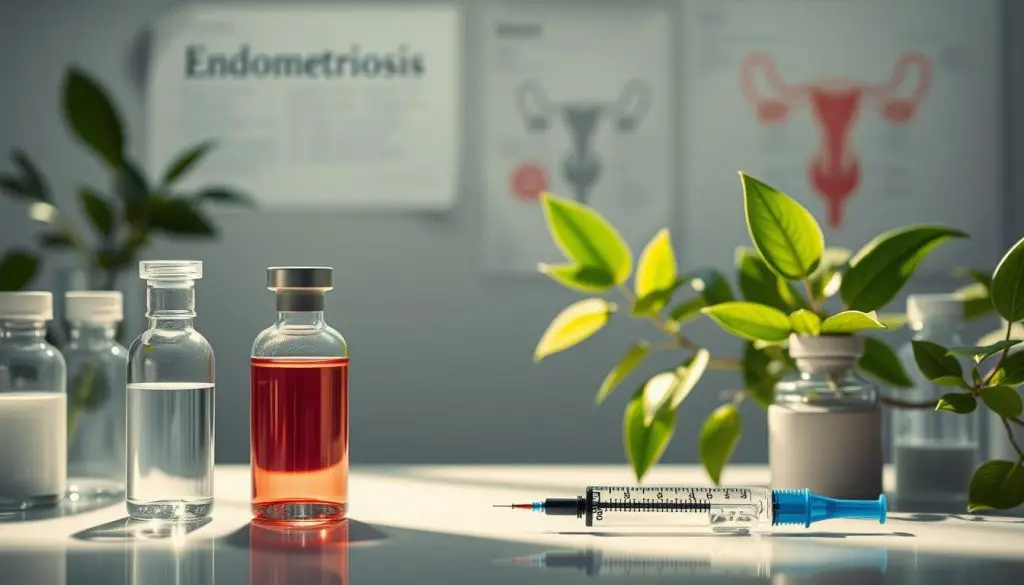Do you suffer from the debilitating effects of endometriosis? This chronic condition causes heavy, painful menstrual bleeding and chronic pelvic pain. It can even lead to infertility challenges. Finding the right menstrual pain medicines can greatly improve your quality of life. But with many options, how do you choose the best ones?
In this guide, we’ll look at over-the-counter and prescription medications for endometriosis pain. We’ll cover anti-inflammatory drugs, hormonal therapies, and interventional treatments. We’ll discuss the pros and cons of each to help you choose the right pain management plan.
Understanding Endometriosis: Symptoms and Causes
Endometriosis is a painful condition where tissue that lines the uterus grows outside of it. This tissue often grows on the ovaries, fallopian tubes, and other pelvic organs. It can cause heavy, painful menstrual bleeding, chronic pelvic pain, and fertility challenges.
Heavy Painful Menstrual Bleeding
One common symptom of endometriosis is heavy, painful menstrual bleeding. The misplaced tissue bleeds, swells, and breaks down like the uterus lining. This leads to very heavy, painful periods that can disrupt daily life.
Chronic Pelvic Pain
Endometriosis also causes chronic pelvic pain that gets worse during menstruation. The misplaced tissue can become inflamed and develop scar tissue. This leads to ongoing discomfort and pain in the pelvic area.
Infertility Challenges
Endometriosis is a major cause of infertility in women. The misplaced tissue can distort the pelvic anatomy and interfere with the egg’s journey. It also makes it harder for the egg to implant and for pregnancy to occur.
| Endometriosis Statistic | Percentage |
|---|---|
| Endometriosis affects 2-10% of American women aged 25-40 | 2-10% |
| Endometriosis affects up to 10% of women aged 15-44 | Up to 10% |
| 24-50% of women with infertility have endometriosis | 24-50% |
The exact cause of endometriosis is not known. But it may be linked to factors like retrograde menstruation, immune system disorders, and hormonal imbalances. Getting medical help and exploring treatment options is key to managing symptoms and complications.
Over-the-Counter Menstrual Pain Medicines
For mild to moderate menstrual pain, over-the-counter (OTC) pain relievers can help. Options include ibuprofen (Advil), naproxen (Aleve), and acetaminophen (Tylenol). These drugs reduce inflammation and ease cramps. It’s best to start taking them a day or two before your period starts.
Ibuprofen (Advil)
Ibuprofen is a good choice for menstrual pain. It can help up to 80% of people with endometriosis-related cramps. But, about 20% of users find little to no relief.
Naproxen (Aleve)
Naproxen is another NSAID for menstrual pain. It might be better for those with severe cramps. Naproxen is taken every 12 hours, while ibuprofen is every 6-8 hours.
Acetaminophen (Tylenol)
Acetaminophen is a pain reliever for menstrual cramps. But, studies show it might not work as well as NSAIDs. Tylenol is often chosen for milder pain.
There are also creams, gels, and patches for minor cramping. If your pain lasts after three to six months of OTC treatment, see a healthcare provider.
Hormonal Therapy for Endometriosis Pain Management
If you’re dealing with the pain of endometriosis, hormonal therapy can change your life. These treatments balance estrogen and progesterone levels. This can slow down the growth of endometrial tissue. You can try progestin-based medications, birth control pills, and gonadotropin-releasing hormone (GnRH) agonists.
Progestins, like the LNG-IUS, can really help with pain. They thin the uterine lining and cut down on menstrual bleeding. This gives many women relief. Birth control pills can also help by stopping menstrual cycles and easing symptoms.
GnRH agonists are strong because they lower estrogen levels, shrinking endometrial implants. But, they can cause side effects like hot flashes and bone loss. Doctors use them for a short time to avoid long-term problems.
| Treatment | Effectiveness | Potential Side Effects |
|---|---|---|
| Progestin-based medications | Highly effective in reducing endometriosis-related pain and bleeding | Weight gain, depression, irregular bleeding |
| Continuous birth control pills | Can suppress menstrual cycles and alleviate symptoms | Headaches, mood changes, breakthrough bleeding |
| GnRH agonists | Reduce endometrial implant size by lowering estrogen levels | Hot flashes, bone loss, decreased libido |
Not every treatment works the same for everyone. Symptoms might come back after stopping treatment. Talk to your doctor to find the right hormonal therapy for endometriosis for you.

Prescription Medications for Menstrual Pain Relief
For severe menstrual pain from endometriosis, prescription drugs might be needed. These include muscle relaxants, certain antidepressants, and anticonvulsants. Even though they’re not approved for endometriosis, they can help manage chronic pelvic pain.
Muscle Relaxants
Medicines like baclofen or tizanidine can ease the cramping and muscle spasms of endometriosis. They target nerves and muscles to reduce tension and pain.
Antidepressants
Antidepressants like desipramine or amitriptyline can also help with endometriosis pain. They tackle the nerve-related pain, easing the pelvic discomfort.
Anticonvulsants
Anticonvulsants, like gabapentin or pregabalin, are sometimes used for endometriosis pain. They stabilize the nervous system and block pain signals, helping with chronic pelvic pain.
| Medication Class | Example Medications | Mechanism of Action |
|---|---|---|
| Muscle Relaxants | Baclofen, Tizanidine | Target nerves and muscles to alleviate cramping and spasms |
| Antidepressants | Desipramine, Amitriptyline | Address neuropathic pain component by modulating neurotransmitters |
| Anticonvulsants | Gabapentin, Pregabalin | Stabilize the nervous system and reduce pain signal transmission |
These prescription drugs can help those with severe endometriosis pain. But, it’s key to work with a healthcare provider to find the best treatment and manage side effects.

Interventional Therapies: Injections and Nerve Blocks
If over-the-counter meds and hormonal treatments don’t help, your doctor might suggest interventional therapies. These procedures, done by pain management experts, aim to find and treat the root of your chronic pain.
Trigger point injections involve putting a local anesthetic, sometimes with a corticosteroid, into tight muscles in your pelvic area. This method can offer temporary pain relief by stopping pain signals from those areas.
Nerve blocks are another option. They numb specific nerves, helping to find or treat the pain’s source. Doctors use X-ray guidance to accurately target the nerves.
Though not a cure, interventional therapies are key in managing pain. Your doctor will decide if these treatments are right for you.
| Interventional Therapy | Description |
|---|---|
| Trigger Point Injections | Injection of local anesthetic, with or without corticosteroid, into tight, tender pelvic muscles to block pain signals. |
| Nerve Blocks | Injection of local anesthetic to numb specific nerves, used diagnostically and therapeutically for pelvic pain. |

Managing endometriosis pain involves more than just injections and nerve blocks. A full plan might include physical therapy, behavioral therapy, and treatments like acupuncture. Working with your healthcare team, you can find the best mix of therapies to manage your symptoms and enhance your life quality.
Physical Therapy for Pelvic Floor Muscle Management
If you’re dealing with endometriosis pain, physical therapy can help. Pelvic floor physical therapists focus on muscle spasms and trigger points. These issues often cause chronic pelvic pain in endometriosis patients.
They use muscle relaxation exercises, biofeedback, and myofascial release. These methods help the pelvic muscles relax and control pain. This physical therapy endometriosis approach is great for those who can’t or don’t respond well to medication.
Research shows physical therapy can be as good as, or even better than, pain meds for menstrual pain. Yoga poses like Cat, Cobra, and Fish also help reduce menstrual pain. A full physical therapy program can greatly reduce period pain.

Other pelvic floor muscle therapy methods, like hot packs and TENS, work well too. Connective tissue mobilization, massage, and acupressure also show great results. These methods address muscle issues, providing relief and improving life quality.
Ready to try physical therapy for endometriosis? Talk to a pelvic floor specialist. They’ll create a treatment plan tailored to your needs. This can help you manage your condition better.
Behavioral Therapy and Stress Management Techniques
Endometriosis can really affect your mood, so using behavioral therapy and stress management can help a lot. A therapist can teach you ways to handle the pain and stress of this condition. Activities like meditation, deep breathing, and visualization can also help some women feel better.
Studies have shown that behavioral therapy can help manage endometriosis-related stress. A study on female college students with premenstrual syndrome (PMS) found that cognitive-behavioral therapy greatly reduced their symptoms. It also improved their overall well-being.
Group cognitive-behavioral therapy was also found to be effective in reducing social interferences caused by PMS symptoms. Techniques like progressive muscle relaxation and mindfulness meditation have been shown to improve neuropathic pain, fatigue, and quality of life in patients with chronic conditions.
Adding these behavioral therapy endometriosis and stress management for endometriosis techniques to your treatment plan can greatly improve your life. It helps you manage both physical and emotional symptoms, leading to a better quality of life.
| Technique | Description | Benefits for Endometriosis |
|---|---|---|
| Cognitive-Behavioral Therapy | A form of psychotherapy that helps patients identify and change negative thought patterns and behaviors | Reduces psychological symptoms, social interference, and overall PMS/PMDD symptoms |
| Meditation and Deep Breathing | Practices that promote relaxation and stress reduction | Provides relief from pain, fatigue, and emotional distress associated with endometriosis |
| Progressive Muscle Relaxation | A technique that involves tensing and relaxing different muscle groups to induce a state of calm | Improves neuropathic pain, fatigue, and quality of life for patients with chronic conditions |
Exploring Acupuncture for Endometriosis Pain Relief
Women with endometriosis often face a tough time finding pain relief. But, some have found help in acupuncture, a part of traditional Chinese medicine.
Acupuncture uses thin needles to help energy flow and heal. Even though there’s not much research, some studies show it can help with endometriosis pain.
One study had 67 people. It found that acupuncture helped reduce menstrual pain by 4.81 points. Also, ear acupuncture was very effective, with a success rate of 91.9%.
Acupuncture might do more than just ease pain. It could also help with feelings of sadness, worry, and improve relationships. Women with endometriosis who tried acupuncture felt better emotionally.
While more studies are needed, the current findings are encouraging. For those looking for a natural way to manage endometriosis, acupuncture for endometriosis and traditional Chinese medicine for menstrual pain might be worth trying.
Remember, acupuncture is meant to be used alongside other treatments, not instead of them. Always talk to your doctor before trying acupuncture for endometriosis. This ensures you get the best care possible.
Surgical Options: Laparoscopy and Hysterectomy
Women with severe or hard-to-treat endometriosis might need surgery. Laparoscopic excision removes endometrial implants with small incisions. Sometimes, a hysterectomy (removing the uterus) is suggested, even if a woman doesn’t want more kids. But, surgery comes with risks and doesn’t always cure endometriosis.
About 600,000 hysterectomies happen in the U.S. each year. This makes it the second most common surgery for women, after cesarean sections. Vaginal hysterectomy has the least complications and the quickest recovery, taking up to four weeks. Abdominal hysterectomy is needed for more complex cases and takes longer to recover from.
Minimally invasive surgeries, like laparoscopic excision and robotic-assisted laparoscopic hysterectomy, have benefits. They lead to shorter hospital stays, less pain, and quicker recovery times. These options are great for women with endometriosis, helping to reduce symptoms and improve life quality.
Women should talk to their doctors about endometriosis surgery options. They need to consider the benefits and risks to choose the best surgery for them. With the right surgery and care, many women with endometriosis can feel better and live better lives.
Menstrual Pain Medicine: Weighing Benefits and Risks
Finding the right balance in treating menstrual pain from endometriosis is key. Over-the-counter NSAIDs like ibuprofen or naproxen can help with pain. But, using them too much can cause stomach issues, nausea, and headaches.
Hormonal therapies, like oral contraceptives, can help with pain and cycle control. Yet, they might cause spotting, weight gain, and mood swings. Prescription drugs, including muscle relaxants and antidepressants, can also offer relief. But, they might have unwanted side effects.
Surgical options, like laparoscopy or hysterectomy, can be effective in some cases. But, they also come with risks of organ damage and infection. It’s important to talk to your healthcare provider about these risks and benefits to find the best treatment for you.
Understanding the benefits and risks of menstrual pain medicines is vital. Talking openly with your doctor can help you find the best solution for managing endometriosis.
Key Considerations:
- Over-the-counter NSAIDs can cause stomach problems, nausea, and headaches with prolonged use.
- Hormonal therapies may lead to side effects like spotting, weight gain, and mood changes.
- Prescription medications can have unwanted side effects, such as drowsiness or dry mouth.
- Surgical options, while potentially effective, carry risks of complications like organ damage or infection.
Talking to your healthcare provider about the trade-offs is essential. This helps find the right treatment for managing menstrual pain from endometriosis.
Natural Remedies and Lifestyle Changes
Women with endometriosis might look into natural ways to ease their symptoms. This includes herbal supplements and lifestyle changes. These options can be a good addition to medical treatments.
Herbal Supplements
Herbal supplements like evening primrose oil, turmeric, and ginger are often used for menstrual cramps. While not all studies agree, some suggest they can help lessen menstrual pain. For example, a 2018 review showed that essential oils like lavender and clary sage can help with abdominal self-massage.
Diet and Exercise
Eating well and staying active can help manage endometriosis symptoms. A diet full of fiber and staying hydrated can ease menstrual cramps. Activities like yoga, meditation, and warm baths can also help with pain.
A 2024 study found that yoga classes twice a week for 12 weeks reduced menstrual pain and symptoms.
Relaxation Techniques
Stress management and relaxation techniques can help with endometriosis-related pelvic pain. Deep breathing, meditation, and warm baths can ease menstrual cramps. Exercise and orgasm also release endorphins, which can help with pain.
It’s safe to try these natural methods, but talk to your doctor first. They might affect your medications or have risks. The goal is to find the right mix of treatments for you.
When to Seek Medical Attention for Severe Pain
If your endometriosis symptoms are causing severe pelvic pain, it’s time to see a doctor. This pain should not stop you from living your life. Work with your healthcare provider to find the best treatment for you.
If you have severe pain, painful sex, blood in your urine or stool, or trouble getting pregnant, call your doctor. These signs might mean your endometriosis is getting worse. You might need more than just pain relievers to feel better.
Don’t ignore severe menstrual cramps that affect your daily life or get worse. Seeing a doctor can help you find relief. With the right treatment, you can manage your symptoms and take back control.
Source Links
- https://medlineplus.gov/ency/patientinstructions/000714.htm
- https://www.mayoclinic.org/diseases-conditions/menstrual-cramps/diagnosis-treatment/drc-20374944
- https://my.clevelandclinic.org/health/diseases/10857-endometriosis
- https://www.hopkinsmedicine.org/health/conditions-and-diseases/endometriosis
- https://www.verywellhealth.com/medicine-for-period-cramps-8420078
- https://www.medicalnewstoday.com/articles/best-medication-for-period-cramps
- https://www.webmd.com/women/endometriosis/understanding-endometriosis-treatment
- https://www.mayoclinic.org/diseases-conditions/endometriosis/diagnosis-treatment/drc-20354661
- https://www.nichd.nih.gov/health/topics/endometri/conditioninfo/treatment
- https://emedicine.medscape.com/article/253812-medication
- https://www.ncbi.nlm.nih.gov/books/NBK279323/
- https://www.mountsinai.org/health-library/condition/menstrual-pain
- https://www.brighamandwomens.org/obgyn/infertility-reproductive-surgery/endometriosis/endometriosis-pain-management-for-adult-women
- https://spinediagnostic.com/interventional-therapies-for-nerve-pain-management/
- https://www.southernpelvichealth.com/blog/can-physical-therapy-help-menstrual-cramps
- https://www.ncbi.nlm.nih.gov/pmc/articles/PMC8345570/
- https://www.ncbi.nlm.nih.gov/pmc/articles/PMC10328656/
- https://www.ncbi.nlm.nih.gov/pmc/articles/PMC4888138/
- https://www.ncbi.nlm.nih.gov/pmc/articles/PMC10682677/
- https://www.ncbi.nlm.nih.gov/pmc/articles/PMC10010596/
- https://my.clevelandclinic.org/health/procedures/hysterectomy
- https://www.webmd.com/women/hysterectomy
- https://www.thewomens.org.au/health-information/periods/heavy-periods/treating-with-surgery
- https://www.webmd.com/women/menstrual-pain
- https://www.webmd.com/women/menstrual-cramps
- https://www.aafp.org/pubs/afp/issues/2021/0800/p164.html
- https://www.medicalnewstoday.com/articles/324484
- https://www.health.com/condition/menstruation/menstrual-pain-natural-remedies
- https://www.healthpartners.com/blog/when-to-see-a-doctor-for-menstrual-cramps/
- https://medlineplus.gov/periodpain.html
- https://www.mayoclinic.org/diseases-conditions/menstrual-cramps/symptoms-causes/syc-20374938
